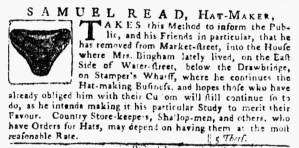What was advertised in a colonial American newspaper 250 years ago today?

“He continues the Hat-making Business, and hopes those who have already obliged him with their Custom will continue so to do.”
When he moved from Market Street to Water Street in Philadelphia, Samuel Read, “HAT-MAKER,” ran an advertisement in the Pennsylvania Gazette to “inform the Public, and his Friends in particular” of his new location. He encouraged “those who have already obliged him with their Custom” to visit his new shop, especially since he “intends making it his particular Study to merit their Favour.” Read also assured “Country Store-keepers, Shallop-men, and others, who have Orders for Hats” that they “may depend on having them at the most reasonable Rate.”
In an effort to draw attention to his advertisement, Read adorned it with a woodcut depicting a tricorne hat, a style so popular at the time that it has become widely associated with late eighteenth-century fashions. Few advertisements in the December 1, 1773, edition of the Pennsylvania Gazette featured visual images. The printers supplied woodcuts of vessels at sea for seven advertisements seeking freight and passengers for ships departing for other ports. Frederick Hubley, a coppersmith in Lancaster, ran the only other advertisement with a woodcut designed for the exclusive use of his business. Readers of the Pennsylvania Gazette became familiar with his woodcut of a still thanks to repeated insertions over several months. Even with those advertisements appearing elsewhere in the newspaper, Read’s advertisement was the only one with a woodcut on the first page.

Read’s woodcut reflected his occupation and distinguished his advertisement from others in the Pennsylvania Gazette, even though it was not as elaborate as a similar image that Nesbitt Deane, a hatmaker in New York, frequently used in his advertisements. Deane’s woodcut depicted a tricorne hat above a ribbon that stated his name. Deane also developed marketing appeals beyond those deployed by Read. For instance, he declared that he devised “a method peculiar to himself, to turn rain, and prevent sweating of the head damaging the crown.”
Read’s advertisement was not as sophisticated as the one that Deane simultaneously ran in Rivington’s New-York Gazetteer, not in terms of the copy nor in terms of the visual image, yet the hatmaker in Philadelphia demonstrated more than a little marketing savvy. His notice did not merely announce that he moved to a new location. Read attempted to maintain existing relationships with his customers by promising that their satisfaction remained his primary concern. He also promised low prices to retailers who would purchase in volume and other customers. The woodcut, plain as it may seem to modern eyes, also drew attention to his advertisement, distinguishing it from most others in that issue of the Pennsylvania Gazette.
